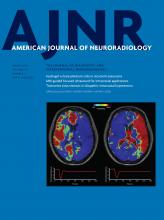We thank Dr. Schweitzer and colleagues for their interest in our recent article, “Computer-Extracted Texture Features to Distinguish Cerebral Radionecrosis from Recurrent Brain Tumors on Multiparametric MRI: A Feasibility Study,” and their feedback and also thank the editor for the opportunity to address the concerns raised.
First and foremost, we must clarify that the preliminary nature of the data is emphasized in the title itself, where the study is identified as “A Feasibility Study.” The study was not meant to be a head-to-head comparison of “standard of care” neuroradiology versus machine performance. Our conclusions were limited to suggesting that radiomic features may provide complementary diagnostic information on routine MR imaging to distinguish radionecrosis from tumor recurrence.
We absolutely agree that the readings were not conducted as “standard of care.” In most cases, research protocols differ from “standard of care.” As an example, RECIST (Response Evaluation Criteria in Solid Tumors) 1.1,1 the international reference standard of response assessment, limits the number of lesions to be tracked on serial scans to 5, even in patients with dozens of lesions. Similarly, in RANO (Response Assessment in Neuro-Oncology) criteria,2 a single bidimensional measurement of the area of enhancement is the central feature tracked serially, with a 50% decrease in area constituting a partial response. When it comes to research, deviation from “standard of care” is indeed standard.
Just as the expert readers in our study were not provided access to prior imaging and a full complement of pulse sequences, the radiomics machine classifier was not provided this information.3 Our experiments were designed to ensure a “fair” comparison between the radiomics classifier and the diagnostic reads by 2 expert readers. Our aim was to demonstrate that the radiomics classifier was able to pull out information from the posttreatment scans, features that may not be discernible or understood through visual analysis by readers. The higher accuracy suggests that the radiomics classifier can serve as a useful adjunct to the human reader in future machine-assisted decision-support studies for this problem.
Regarding the concern regarding mixed pathologies (both primary and metastatic cases), it should be noted that the disparity between accuracy was entirely related to the assessment of primary tumors. The addition of metastases to the study had no impact on the disparity between “man and machine.”
We also agree with Dr. Schweitzer et al that advanced imaging has much to offer. In point of fact, in a pilot study of 28 cases evaluated with FDG-PET-MR imaging incorporating perfusion, both the sensitivity and specificity of PET-MR imaging was 100%.4 The success of this pilot study notwithstanding, there are obvious advantages to maximizing the yield of existing scan data rather than carrying out additional imaging due to cost savings and better quality of life for the patient. There are several FDA-approved examples of decision-support solutions that use routine MR imaging scans, including products from Riverain, GE Healthcare, and iCAD, being used by radiologists in clinical decision-making for different oncology applications (eg, breast, prostate, and colon cancer). Further, contrary to the comments on difficulty in computation by using radiomics, our analysis did not require any advanced high-performance server or workstation and was run on a standard machine (Core i7 processor, 16 GB RAM) with off-the-shelf hardware. The computational analysis took less than a minute per study to render diagnosis.
Lastly, Dr. Schweitzer et al expressed concerns about bright medical students choosing other medical fields over radiology. It is indeed unfortunate that our paper has been used as the basis for sensationalist journalism. In the early days of MR imaging, because the technique did not depend on ionizing radiation, a background in radiation biology was not needed to administer it to patients. As a result, there was a fear among radiologists that they would lose control of the technique. The joke was that the acronym “NMR” stood for “No More Radiologists.” A few years later, once “NMR” was replaced with the name “MR imaging,” it was joked that the acronym stood for “More Radiologist Income.” Joking aside, the key was that radiologists did not attempt to discredit the new technique, but mastered it instead.
In his recent commentary on our article5 entitled “Am I about to Lose My Job?!”, Dr. Andrei Holodny states, “… working with computers, rather than some apocalyptical struggle against them, will lead to optimal results for the patients we serve.”
The era of “computer-assisted diagnosis” is upon us. Running and hiding from it would be the greatest disservice to young radiologists. The key to not being replaced by the machines is to be the one using the machines.
- © 2017 by American Journal of Neuroradiology







